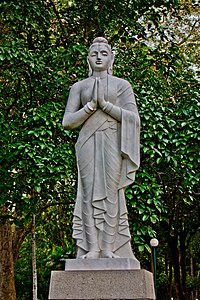This article needs additional citations for
verification. (January 2010) |
| Queen Viharamaha Devi | |
|---|---|
 Statue of Queen Viharamahadevi | |
| Tenure | 205 BC - 161 BC |
| Born | Kelaniya |
| Spouse | Kavan Tissa |
| Issue |
Dutugamunu Saddha Tissa |
| Father | Kelani Tissa (Tissa of Kelaniya) |
| Religion | Theravāda Buddhism |
Viharamahadevi [1] ( Sinhala:විහාරමහාදේවි) was the mother of King Dutugamunu, Saddhatissa and the Queen consort of King Kavantissa (King of the Ruhuna Sri Lanka). [2] Some scholars suggest that her original name was 'śavera', which possibly means goddess of the night. [3] [4]
Life
Queen Viharamahadevi was the daughter of King Kelanitissa who ruled Kelaniya. [5] The king once punished an innocent monk by boiling him alive in a cauldron of oil. [6] [7] It is said that the gods, angered over this cruel deed, made the ocean rush inland and flood the land. [8] Soothsayers said that if a princess was sacrificed to the sea, the raging waves would stop. The young princess was placed inside a beautifully decorated boat which bore the letters Daughter of a King and set adrift on the sea. [9] [8]
It is said that as soon as she was sent off, the sea suddenly turned calm again and the water receded. However, the king was very upset, the queen was wailing and the citizens were very angry over the loss of their brave princess. They all started blaming the king. [10] [9]
Meanwhile, the young princess finally reached the shore, at a spot known as Dovera in Kirinda, in the southern part of the country, then known as Rohana (now Ruhuna) which was a quite prosperous area ruled by King Kavantissa. A fisherman who first spotted the boat is said to have run to the castle, and informed the king about the castaway princess. The Thupavamsa says birds who first spotted the floating boat informed the king. [9] [11] [12]
The princess was brought before the king in a procession. The king, on hearing her story, was so impressed that he decided to marry the princess who had been so brave and patriotic to sacrifice her life for her country. As a part of the legend it's said as she reached the shore at a spot close to the Lanka Vihara, she was named Viharamahadevi. [13] [14] [15] The place where she landed is marked with an inscription laid there by Prince Mahanaga.
She bore the king two sons, Dutugemunu and Saddhatissa. The former is one of the greatest heroes of Sri Lanka, while Viharamahadevi herself is recognised as a great heroine of Sri Lanka. She convinced her son Dutugamunu to fight, and defend the kingdom from invasion. [16] [17] [18] [19]
See also
References
- ^ "Kirinda - Legend of Queen Viharamaha Devi".
- ^ "Introduction", The Sri Lanka Reader, Duke University Press, pp. 1–7, 2011, doi: 10.1215/9780822394051-001, ISBN 978-0-8223-4967-9, retrieved 2024-02-05
- ^ W. D. J. Benilie Priyanka Emmanuel, Civilization in its Own Words: Inscriptions and Archaeology in Ancient Sri Lanka, University of California, PhD, 2000 p.94
- ^ "ඉන්ස්ක්රිප්ෂන්ස් ඔෆ් සිලොන් වොලුයුම් I කොට්ටදැමූහෙල 556 ශ්රී ලංකා අභීලේඛන - ශ්රී ලංකා අභිලේඛන පිළිබඳ අන්තර්ජාල දත්ත ගබඩාව".
- ^ "Viharadevi was born at Arugambay??".
- ^ Peebles, Patrick (2015-10-22). Historical Dictionary of Sri Lanka. Rowman & Littlefield. ISBN 978-1-4422-5585-2.
- ^ Bindloss, Joe; Butler, Stuart; Mayhew, Bradley; Walker, Jenny (2022-04-22). Lonely Planet Sri Lanka. Lonely Planet. ISBN 978-1-83869-266-7.
- ^ a b Gad-el-Hak, Mohamed (2008-06-23). Large-Scale Disasters: Prediction, Control, and Mitigation. Cambridge University Press. ISBN 978-1-139-47229-6.
- ^ a b c Ratnatunga, Manel (1999). Best Loved Folk Tales of Sri Lanka: Legends and Folklore. Sterling Publishers. ISBN 978-81-207-2011-4.
- ^ Goonasekera, Sunil (2007). Walking to Kataragama. International Centre for Ethnic Studies. ISBN 978-955-580-110-2.
- ^ Thabrew, W. Vivian De (2013). Monuments and Temples of Orthodox Buddhism in India and Sri Lanka. AuthorHouse. ISBN 978-1-4817-9551-7.
- ^ Punchihewa, Gamini de S. G. (2004). Splendours of Ruhuna's Heritage. Stamford Lake. ISBN 978-955-8733-61-5.
- ^ Cambridge Papers in Social Anthropology. Published for the Department of Archaeology and Anthropology at the University Press. 1968.
- ^ Seneviratne, Maureen (1969). Some Women of the Mahavamsa and Cūlavamsa. H. W. Cave.
- ^ Brohier, Richard Leslie (1965). Seeing Ceylon in Vistas of Scenery, History, Legend, and Folklore. Lake House Investments.
- ^ Women of Sri Lanka: A Special Publication on the Status of Women for International Women's Year. Ministry of Information and Broadcasting. 1975.
- ^ The Maha-Bodhi. Maha Bodhi Society of India. 1930.
- ^ Khayal, Priydarshi Thakur (2020-12-01). The sigiriya paw. Redgrab Books pvt ltd. ISBN 978-81-948452-6-3.
- ^ Meegama, Indrani (2003). With a Fistful of Rice: Buddhist Women and the Making of Mahamaya Girls' College. The College. ISBN 978-955-8904-00-8.